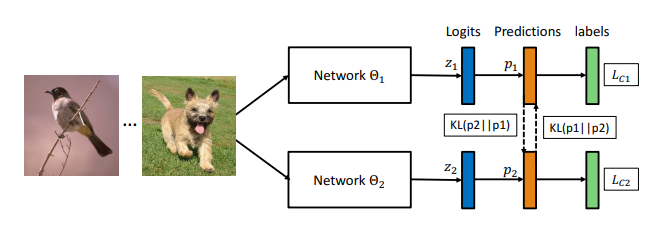Deep Mutual Learning using KD_Lib¶
- Deep Mutual Learning is an online algortihm wherein an ensemble of students learn collaboratively and teach each other throughout the training process.
- Rather performing a one way transfer from a powerful and large and pre-trained teacher network, DML uses a pool of untrained students who learn simultaneously to solve the task together.
- Each student is trained with two losses: a conventional supervised learning loss, and a mimicry loss that aligns each student’s class posterior with the class probabilities of other students.
Snippet from the paper illustrating the DML algorithm -

To use DML with KD_Lib, create a list of student models (student cohort) to be used for collective training and a list of optmizers for them as well. The student models may have different architectures. Remember to match the order of the students with that of their optimizers in the list.
To use DML with 3 students on MNIST -
import torch
import torch.nn as nn
import torch.optim as optim
from torchvision import datasets, transforms
from KD_Lib.KD import DML
# Define datasets, dataloaders, models and optimizers
train_loader = torch.utils.data.DataLoader(
datasets.MNIST(
"mnist_data",
train=True,
download=True,
transform=transforms.Compose(
[transforms.ToTensor(), transforms.Normalize((0.1307,), (0.3081,))]
),
),
batch_size=32,
shuffle=True,
)
test_loader = torch.utils.data.DataLoader(
datasets.MNIST(
"mnist_data",
train=False,
transform=transforms.Compose(
[transforms.ToTensor(), transforms.Normalize((0.1307,), (0.3081,))]
),
),
batch_size=32,
shuffle=True,
)
# Set device to be trained on
device = torch.device("cuda:0" if torch.cuda.is_available() else "cpu")
# Define a cohort of student models
student_model_1 = <your model>
student_model_2 = <your model>
student_model_3 = <your model>
student_cohort = (student_model_1, student_model_2, student_model_3)
# Make a list of optimizers for the models keeping in mind the order
student_optimizer_1 = optim.SGD(student_model_1.parameters(), 0.01)
student_optimizer_2 = optim.SGD(student_model_2.parameters(), 0.01)
student_optimizer_3 = optim.SGD(student_model_3.parameters(), 0.01)
optimizers = [student_optimizer_1, student_optimizer_2, student_optimizer_3]
# Train using KD_Lib
distiller = DML(student_cohort, train_loader, test_loader, optimizers,
device=device)
distiller.train_students(epochs=5, plot_losses=True, save_model=True) # Train the student cohort
distiller.evaluate() # Evaluate the student models